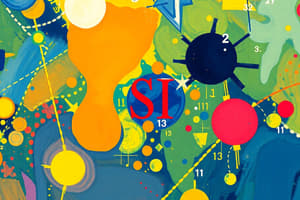Podcast
Questions and Answers
Which of the following is NOT a base unit in the SI system?
Which of the following is NOT a base unit in the SI system?
- Newton (N) (correct)
- Second (s)
- Ampere (A)
- Kilogram (kg)
What type of error is consistently produced due to flaws in measurement equipment?
What type of error is consistently produced due to flaws in measurement equipment?
- Systematic Errors (correct)
- Random Errors
- Human Errors
- Environmental Errors
What is the derived unit for pressure in the SI system?
What is the derived unit for pressure in the SI system?
- Pascal (Pa) (correct)
- Newton (N)
- Joule (J)
- Kilogram (kg)
How should measurements be reported to effectively communicate precision?
How should measurements be reported to effectively communicate precision?
Which prefix denotes a factor of 10⁻⁶ in the SI unit system?
Which prefix denotes a factor of 10⁻⁶ in the SI unit system?
Flashcards are hidden until you start studying
Study Notes
SI Units
- Definition: The International System of Units (SI) is the standard metric system used for scientific measurements.
- Base Units: There are seven base SI units:
- Meter (m) - Length
- Kilogram (kg) - Mass
- Second (s) - Time
- Ampere (A) - Electric current
- Kelvin (K) - Temperature
- Mole (mol) - Amount of substance
- Candela (cd) - Luminous intensity
- Derived Units: Combinations of base units, e.g.:
- Newton (N) - Force (kg·m/s²)
- Joule (J) - Energy (N·m)
- Pascal (Pa) - Pressure (N/m²)
- Prefixes: Used to express multiples or fractions of units:
- Kilo (k) - 10³
- Mega (M) - 10⁶
- Giga (G) - 10⁹
- Milli (m) - 10⁻³
- Micro (μ) - 10⁻⁶
- Nano (n) - 10⁻⁹
Measurement Errors
-
Definition: Differences between the measured value and the true value.
-
Types of Errors:
- Systematic Errors: Consistent, repeatable errors due to flaws in equipment or methodology (e.g., calibration issues).
- Random Errors: Variability in measurements due to unpredictable factors (e.g., environmental changes).
-
Sources of Errors:
- Instrumental errors (faulty equipment)
- Human errors (misreading instruments)
- Environmental factors (temperature, humidity)
-
Measurement Uncertainty:
- A quantification of the doubt about the measurement result.
- Expressed as ± a margin or as a percentage.
-
Reducing Errors:
- Regular calibration of instruments.
- Using proper measurement techniques.
- Taking multiple measurements and averaging results.
-
Significant Figures:
- Important for indicating precision in measurements.
- Rules:
- All non-zero digits are significant.
- Zeros between significant digits are significant.
- Leading zeros are not significant.
- Trailing zeros in a decimal number are significant.
-
Reporting Measurements:
- Should include the measurement value and its uncertainty, e.g., 10.0 ± 0.1 m.
SI Units
- Definition: Standard metric system for scientific measurements known as the International System of Units (SI).
- Base Units: Seven essential units form the foundation of SI measurements:
- Meter (m): Measures length.
- Kilogram (kg): Measures mass.
- Second (s): Measures time.
- Ampere (A): Measures electric current.
- Kelvin (K): Measures temperature.
- Mole (mol): Measures amount of substance.
- Candela (cd): Measures luminous intensity.
- Derived Units: Formed using base units to express complex measurements:
- Newton (N): Represents force (kg·m/s²).
- Joule (J): Represents energy (N·m).
- Pascal (Pa): Represents pressure (N/m²).
- Prefixes: Used to denote multiples or fractions of units:
- Kilo (k): Represents 10³.
- Mega (M): Represents 10⁶.
- Giga (G): Represents 10⁹.
- Milli (m): Represents 10⁻³.
- Micro (μ): Represents 10⁻⁶.
- Nano (n): Represents 10⁻⁹.
Measurement Errors
- Definition: Variations between measured values and true values that indicate inaccuracies.
- Types of Errors:
- Systematic Errors: Consistent errors due to equipment flaws or methodology issues (e.g., calibration errors).
- Random Errors: Unpredictable variations in measurements caused by external or unaccounted factors.
- Sources of Errors:
- Instrumental Errors: Result from faulty equipment impacting measurement accuracy.
- Human Errors: Caused by mistakes in reading or recording measurement data.
- Environmental Factors: Influences such as temperature and humidity that affect measurement conditions.
- Measurement Uncertainty: Reflects the doubt about a measurement result, quantified as a margin of error or percentage.
- Reducing Errors:
- Conduct regular calibration of measuring instruments.
- Employ proper measurement techniques to ensure accuracy.
- Perform multiple measurements and calculate averages for reliability.
- Significant Figures: Indicate precision in measurements with specific rules:
- All non-zero digits count as significant.
- Zeros between significant digits count.
- Leading zeros do not count.
- Trailing zeros in decimal values count as significant.
- Reporting Measurements: Required format includes the measurement value along with its uncertainty (e.g., report as 10.0 ± 0.1 m).
Studying That Suits You
Use AI to generate personalized quizzes and flashcards to suit your learning preferences.




